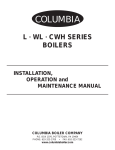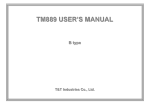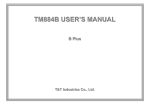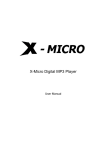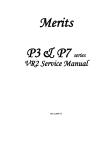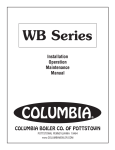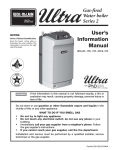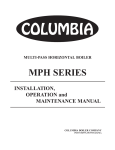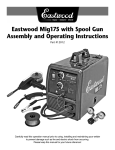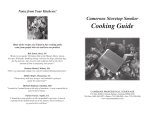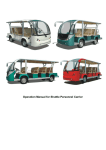Download Columbia EMG-31 140 Operating instructions
Transcript
EMG Series Boilers Available in Natural Gas & Propane Rev 12012 Columbia Boiler Company PO Box 1070 • Pottstown, PA 19464 • Tel (610) 473-8457 • Fax (610) 367-6800 Website www.columbiaboiler.com • Email [email protected] Safety Instructions - Read Before Installing & Operating Equipment W Waarrnniinngg:: If you do not follow these instructions exactly, a fire or explosion may result causing property damage, personal injury or loss of life A) This appliance does not have a pilot. It is equipped with an ignition device which automatically lights the burner. Do not try to light the burner by hand. B) Before operating equipment smell around the appliance area for gas. Be sure to smell next to the floor because some gas (specifically L.P.) is heavier than air and will settle to the floor. C) If you smell gas: 1) Do not try to light any appliance 2) Do not touch any electric switch 3) Do not use any phone in the building 4) Contact your gas supplier immediately using a neighbor’s phone 5) Follow the gas supplier’s instructions D) Use only your hand to push in or turn the gas control knob. Never use tools. If the knob will not push in or turn by hand, don’t try to repair it, call a qualified service technician. Force or attempted repair may result in afire or explosion. E) Do not use appliance if any part has been under water. Immediately call a qualified service technician to inspect the appliance and to replace any part of the control system and any gas control which has been under water. Operating Instructions – Quick Reference 1) Read all instructions prior to operating equipment. 2) Set the thermostat to the lowest setting. 3) Turnoff all electric power to the appliance. 4) This device is equipped with an ignition device which automatically lights the burner. Do not try to light the burner by hand. 5) If the gas control knob is not in the “OFF” position, turn knob clockwise to the “OFF” position. 6) Wait five (5) minutes to clear out any gas. Then smell for gas, including near the floor. If you smell gas, stop immediately. 7) Turn gas control knob counter-clockwise to “ON”. 8) Turn on all electric power to the appliance. 9) Set the thermostat to the desired setting. 10) If the appliance does not operate, follow the instructions. Turning Gas Off To Appliance – Quick Reference 1) Set the thermostat to lowest setting. 2) Turn off electric power to the appliance if service is to be performed. 3) To turn off gas to the appliance, turn the gas control knob clockwise to “OFF”. Contents Safety Instructions i Product Features 1 Installation 3 Start Up 6 Maintenance 8 Trouble Shooting 9 Parts 12 Over fifty years of engineering and product development have gone into your new Columbia boiler. Its quality and design are unsurpassed. Properly installed and maintained, it will provide many years of efficient and dependable operation. Please read this instruction manual carefully. The information contained within is designed to help you maintain peak performance from your unit. Product Features • • • • • • • ASME Coded Boiler Registered with National Board Factory Mounted / Wired Burner and Controls Fully Insulated Heat Exchanger with Powder-Coated Cabinet Packaged with Standard Five Gallon per Minute Tankless Coil (Domestic Hot Water) Equipped with Triple Aquastat, Circulator, Temperature / Altitude Gauge and Gas Regulator Outfitted with Additional Orifices to Achieve a Variety of Heat Inputs Provided with a Lifetime Limited Warranty • EMG-31 120 EMG-31 140 EMG-31 160 Input (Btu/Hr)* 120,000 140,000 160,000 IBR Heat Capacity (Btu/Hr) 88,000 101,000 114,000 Valve Capacity (Lbs/Hr) 160 160 160 Max Water Pressure (Psi) 30 30 30 Burner Model Carlin EZ-Gas Carlin EZ-Gas Carlin EZ-Gas Fuel Type Nat. Gas L.P. Gas Nat. Gas L.P. Gas Nat. Gas L.P. Gas 0.242” 11/64 0.250” 13/64 0.290” 7/32 Fuel Input Rate (Cfm) 1.95 0.79 2.28 0.95 2.60 1.06 Max. Inlet Pressure (“W.C.) 11” 11” 11” 11” 11” 11” Min. Inlet Pressure (“W.C.) 5” 5” 5” 5” 5” 5” Manifold Pressure (“W.C.) 3.5” 3.5” 3.5” 3.5” 3.5” 3.5” Factory Set Factory Set Factory Set Factory Set Factory Set Factory Set 31% 30% 45% 42% 65% 78% Draft Over Fire (“W.C.) -0.02” -0.02” -0.010” -0.02” -0.005” -0.005” Draft in Stack (“W.C.) -0.02” -0.02” -0.02” -0.015” -0.02” -0.02” CO2 Reading 9.0% 11.0% 9.0% 11.0% 9.0% 11.0% AFUE 83.8% 83.8% 83.0% 83.0% 82.2% 82.2% Orifice Size Head Position Air Shutter Boiler Dimensions Water Content 21 Gallon Coil Capacity 5 GPM A) Jacket Height 45” B) Jacket Width 21” C) Hydronic Supply Height 43” D) Coil Supply Height 41” E) Burner Height 8-1/2” F) Hydronic Return Height 21-1/2” G) Flue Pipe Diameter H) Washout I) Jacket Depth (Including Flange) 6” 21-1/2” 21” Depth Front to Rear w/ Burner 29-3/4” Hydronic Supply Size 1-1/4” Hydronic Return Size 1-1/4” Washout Size 3/4” Installation Procedure W Waarrnniinngg:: Unit installation must be performed only by a qualified serviceman that is familiar with state and local codes. 1) Inspect the boiler package to ensure that no damage occurred during shipment. Please contact the distributor immediately if there is any sign of damage. 2) Maintain the boiler package in its protective crate as long as possible to prevent any damage when positioning the boiler. When the boiler package is located adjacent to its final position, the protective crate may be removed by first cutting the banding (Note: bands are under tension and will spring back when cut) and then by prying the individual crate panels. In addition, remove the lag bolts which hold the boiler onto the skid. 3) Place the boiler on a level floor as near to the chimney as possible. Adhere to the following minimum clearances to combustible material: a. b. c. d. e. f. Floor – Non Combustible Floor Only Sides – 6” Rear – 6” Front – 24” Top – 38” Chimney Connector (Vent Pipe) – 18” For clearances less than the listed values, please consult National Fire Protection Agency (NFPA) -54 National Fuel Gas Code Table 6.2.3(B). 4) Ensure that there is adequate combustion air for the burner. Lack of adequate combustion air may result in noisy combustion, erratic burner operation, and/or nuisance lock outs. In addition, the lack of combustion air will result in a shift of the burner’s performance curve and may result in the generation of CO gases inside of the heat exchanger. Please refer to the Start Up Procedure & Annual Maintenance Requirement sections for instructions on setting up and servicing the burner. For installations in utility rooms or closets, it is necessary to provide two separate ventilation openings in the door (one located at 12” and the other 60”). Each opening shall be 160 square inches in size. For installations in buildings with tight construction (little fresh air infiltration), it is necessary to place an opening in the exterior wall that is 160 square inches in size and is located adjacent to the boiler. 5) Install piping for the hydronic and domestic hot water systems. Utilize the 1-1/4” coupling located on top of the boiler for the hydronic system supply and the 1-1/4” nipple at the midpoint of the front face for the hydronic system return. Connect the hot water system to the 1/2” copper fittings located on the coil plate. The right side adapter is for incoming cold water and the left side for outgoing hot water. Pipe the hydronic and hot water systems as detailed in the following figure. Ensure that all fittings are tight before filling the system. 6 Note: Installer responsible for ensuring that piping conforms to all applicable codes 7 6) Wire 120 VAC to the aquastat control. Ensure that the hot wire (black) is connected to the L1 connector, the neutral wire (white) to the L2 connector and the grounding wire (bare) to the green screw in the control panel. The burner, circulator and control are installed at the factory and do not require any additional wiring. In addition, it is recommended that a service disconnect be installed in line with the boiler so that the system may be de-energized for maintenance and emergencies. All wiring performed at the installation must comply with local code and NFPA -70 National Electric Code. See burner manual and control manual for wiring instructions. 7) Follow burner manufacturers instructions for preparation, installation, mounting and operation of the burner. 8) Connect the flue from the boiler to a 6” listed venting system. For chimney vent systems the maximum horizontal length must not exceed 10’. Listed draft boosters and regulators may be used to increase or decrease the draft respectively. The chimney flue must extend 3’ above the highest point of the roof line and 2’ above the highest structure located in a 10’ radius Start Up Procedure 9) Make sure service switch to boiler is off. 10) Make sure boiler has been filled with water until entire system has been purged of air (System pressure must not exceed 30 PSI). 11) Check burner and install desired orifice. See burner manual for instructions. All units are shipped from the factory with an orifice for each firing rate and natural gas or LP gas. Select the correct orifice for you application from the chart in this manual and install per burner instruction manual. 12) Make sure all manual shut off valves in the gas line are open. 13) Bleed off any air in the gas line by attaching a 1/8” NPT nipple and stop cock to the inlet side of the gas valve. Once a faint smell of gas is noticeable at the fitting, immediately shut off the stop cock. Allow the gas to dissipate for a period of five minutes prior to proceeding to the next step. 14) Set the low and high limit of the aquastat operating control to 160oF and 180oF, respectively. 15) Apply power to the system by turning the service switch on. 16) Review the burner manual for additional start-up and operating instructions. Burner Adjustment See burner manual for complete adjustment and operating instructions. Note: The combustion chamber takes approximately 2 hours to cure after starting burner operation. During that time elevated CO levels will occur until the chamber is cured. 17) For chimney vent applications drill out a small sampling port in the stack (locate approximately 6” away from the boiler). 8 18) Attach a 1/8” NPT nipple and stop cock to the outlet side of the gas valve. Regulator Adjustment Screw 19) Attach a manometer to the nipple / stop cock assembly and take a reading of the gas pressure. 20) Make sure the manifold pressure is set at 3.5” W.C. Adjustments can be made to the manifold pressure by turning the set screw located on the gas valve. Gas pressure is increased by turning the set screw clockwise and decreased by turning the screw counterclockwise. 21) Allow the boiler to fire for a period of 10 – 15 minutes in order to reach the desired operating temperature. 22) Take a flue measurement at the sampling port. Draft should be slightly negative for chimney vent applications (-0.01” to -0.04”). Adjustments to the draft can be made by installing a listed draft inducer or draft regulator. 23) Take a CO2 measurement using a combustion analyzer. Adjust the air shutter so that the CO2 reading measures 9.0%. Increase the air shutter opening to decrease the CO2 value and decrease the air shutter opening to increase the value. 24) Use the combustion analyzer to verify that the CO level is below 100 ppm and that the flue temperature is above 375oF. 25) Cover the drilled out sample port either by applying a silicon sealant or high temperature tape. It is important to cover the sample port to prevent flue gases from infiltrating through the opening. Annual Maintenance Requirements 1) 2) 3) 4) Inspect gas line for leaks. Inspect exhaust venting for leaks. Clean blower wheel. Inspect electrode tips for unnecessary wear. 5) Take an ohmmeter reading of the flame sensor. 6) Clean air intake. 7) Inspect coil gasket (retighten bolts if necessary). 9 Trouble Shooting the System See burner manual for trouble shooting burner related problems. Draft Take a draft reading; draft should be -0.02” for chimney vent Down drafts Install a listed vent cap Insufficient draft Install a listed draft inducer Excessive draft Install a listed draft regulator Trouble: Boiling Noise in Top of Boiler Source Procedure Causes Remedy Air Trapped in Boiler / System Check if boiler / system is properly vented (purged) Defective float vent Replace vent Waterlogged expansion tank Drain tank Manual air vent requires venting Open air vent Improper piping (air trapped at highest point of piping) Install air vent at highest point of piping Trouble: Too Much Heat Source Procedure Causes Remedy Circulator Check to see if Aquastat is operating properly Circulator does not stop running Repair Thermostat Check thermostat settings and calibration Thermostat set too high Reset thermostat Thermostat defective Replace thermostat Thermostat out of calibration Recalibrate thermostat Flow valve dirty & stuck Clean flow valve Flow valve defective Replace flow valve Flow Valve Check to see if flow valve is operating properly Trouble: Insufficient Domestic Hot Water Source Procedure Causes Remedy Operating Control Check operating control Setting too low Set operating control to 180oF Coil Heat Exchanger Inspect coils for fouled surfaces and / or flow restrictions Flow restriction Remove restriction Fouled surfaces on heat exchanger Clean heat exchanger surface 10 Trouble: Insufficient Heat Source Procedure Causes Remedy Circulator Check if circulator is operational Coupling worn or broken Replace coupling Pump binding Replace pump Circulator motor burned out Replace circulator motor Wiring from operating control defective Repair wiring Check thermostat settings Settings too low Increase setting Check thermostat location Bad location due to heat buildup Move thermostat to an alternate location Out of calibration Recalibrate or replace thermostat Thermostat Flow Valve Check flow valve for sticking in partially closed position Flow valve not opening fully Clean or replace flow valve Radiation Check radiators for air Check to ensure radiators are properly sized Radiators air bound Radiators inadequate Bleed radiators Install alternate radiators Boiler Determine required heat load Boiler too small for application Additional heating capacity required Tankless Coil Check usage of domestic hot water Demand too large Install flow regulator Piping Check to ensure piping is properly sized Piping inadequate Repipe system Burner Increase gas manifold pressure by opening up the gas valve Decrease in gas line pressure Check with gas company for changes in service Additional boiler capacity required Check for leaks upstream of burner 11 Available Replacement Parts Item Description Boiler Part Numbers 307120 FT Baffle (8 Required) 305712 FT 6” Flue Box 337070 Gasket Material for Flue Box (25’ spool) 790330 Columbia Blank Coil Plate with 1/8” and 3/4” Tapping 481011 Columbia Coil Gasket 530675 Columbia 5 Gallon Coil Assembly with Gasket (Boxed) 337350 FT Fire Chamber 221750 FT Base Assembly Boiler Accessory Part Numbers 535030 Taco 007 Circulator Pump 559560 Altitude Gauge 1/4” x 2-1/2” Round 575020 Relief Valve (3/4” Male) 12












